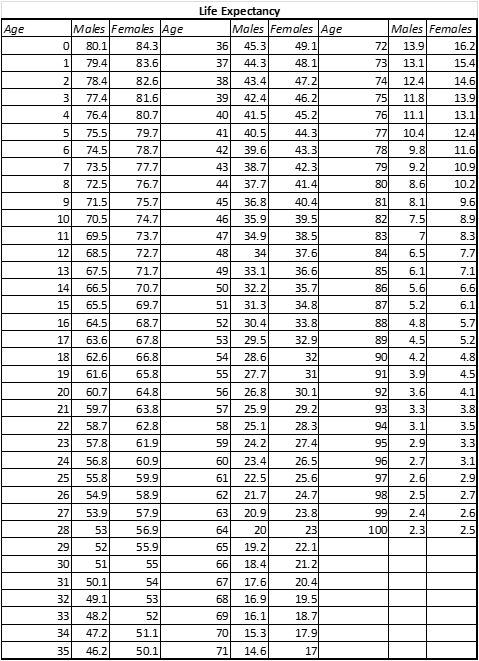Me or my money – who will last longer?
With the release of the latest Australian Bureau of Statistics Life Expectancy tables this question again becomes highlighted in people’s minds, both in regards to funding retirement personally, or obtaining pension benefits from the Australian Government.
Australia is now one of only four countries that have a life expectancy of greater than 80 years (Switzerland, Japan and Iceland beat us to it).
A 65 year old male today is expected to live to 84, and a 65 year old female is expected to live to 87.
I have provided a table below with the updated data based on the Australian population.
It is important to remember that these numbers are an average life expectancy; on average half of the population may live longer still. Retirement at 65 may mean that you require self or pension funding for at least 20 if not 30 years or more (would be unfortunate to plan to have funding to 84 and find you need it to 96!)
There are currently estimated to be 14.7% of the population aged 65 and over today (3.45 million people), with this number expected to grow to approximately 17% of the population (4.79 million – an increase of 1.34 million) within the next 10 years.
These figures make it much more apparent to the average Joe why the government is looking at measures to reduce the number of people that rely on the Age Pension, as well as reducing the pension amount for those that do qualify, as higher costs are required to support our Ageing population from a potentially smaller number of tax payers. Quite simply, your children and their children may not have the benefit of an Age Pension when they eventually retire (or at least a very small proportion relative to today’s pension rates), as the cost to provide this becomes greater, and is provided for longer.
To visualise the projected population over time and our overall demographic break up both now and in the future, you can access the Australian Bureau of Statistics Population Pyramid. Moving the slider at the bottom of this graphic will show you changes forecast over time.
For those currently or soon retiring, the new data may mean that you need to revisit what you thought may be a sustainable retirement income from your superannuation assets in the short term, to extend the longevity of your funds, as one of the most significant variables to how long your investment and superannuation assets will last is the level of funding being taken to meet living expenses. It may mean looking at ways to reduce expenses, generate additional income, or even part participation in the workforce may be required.
For those with more than 10 years to retirement, it shows only one thing – that the strain on the taxpayer will continue to increase due to an aging population, while expected welfare benefits in retirement will most likely fall in relative value. This will have a profound impact as people adjust to the need to saving more for retirement now (which can mean lower current discretionary spending). This will either be a conscious decision by individuals, or being forced via legislation to increase the employer contribution amount (with a potential reduction in pay increases as a result of higher employment costs borne by employers). This has already been commenced through the employer contribution rate moving to 9.25% of salary, however much research has been done to suggest that this rate or even 12% will not be sufficient. For those that therefore do not choose to save more of their income today than what they are forced to, lower retirement incomes in the future will be the outcome.
Regardless of whether you have retired, are approaching retirement, or have many years to prepare, it is important that your investments match your investment time frame. If you have a 30 year retirement to plan for, and you hold too much exposure to cash or term deposits earning less than 3%, there is a greater possibility that you run your nest egg down too soon, as there is insufficient growth to offset the level of retirement funding being drawn in most cases.
At the other extreme, too high an allocation to growth assets with a corresponding increase in volatility i.e. risk, can also have adverse results.
Early planning or adjustment, regardless of age, can assist to ensure that your retirement years are spent doing the things you love, rather than worrying about whether you will be able to pay the power bill next month. Have your affairs reviewed, and ensure your family and friends do the same, and start preparing now to have a greater potential retirement income from which to enjoy your lifestyle.
*All data for this article has been obtained from “3302.0.55.001 – Life Tables, States, Territories and Australia, 2011-2013”, Australian Bureau of Statistics, https://www.abs.gov.au/AUSSTATS/abs@.nsf/DetailsPage/3302.0.55.0012011-2013#Data.


